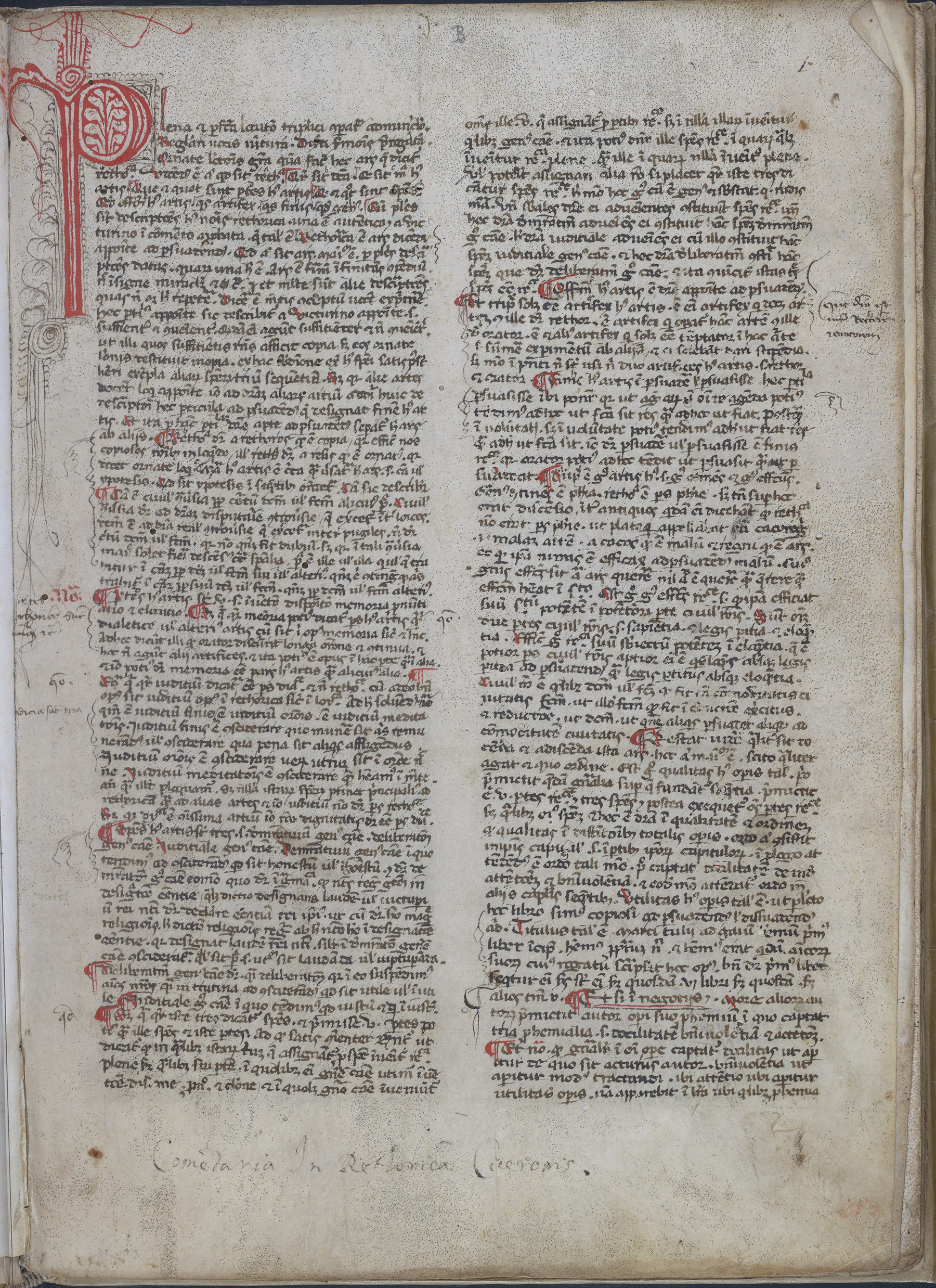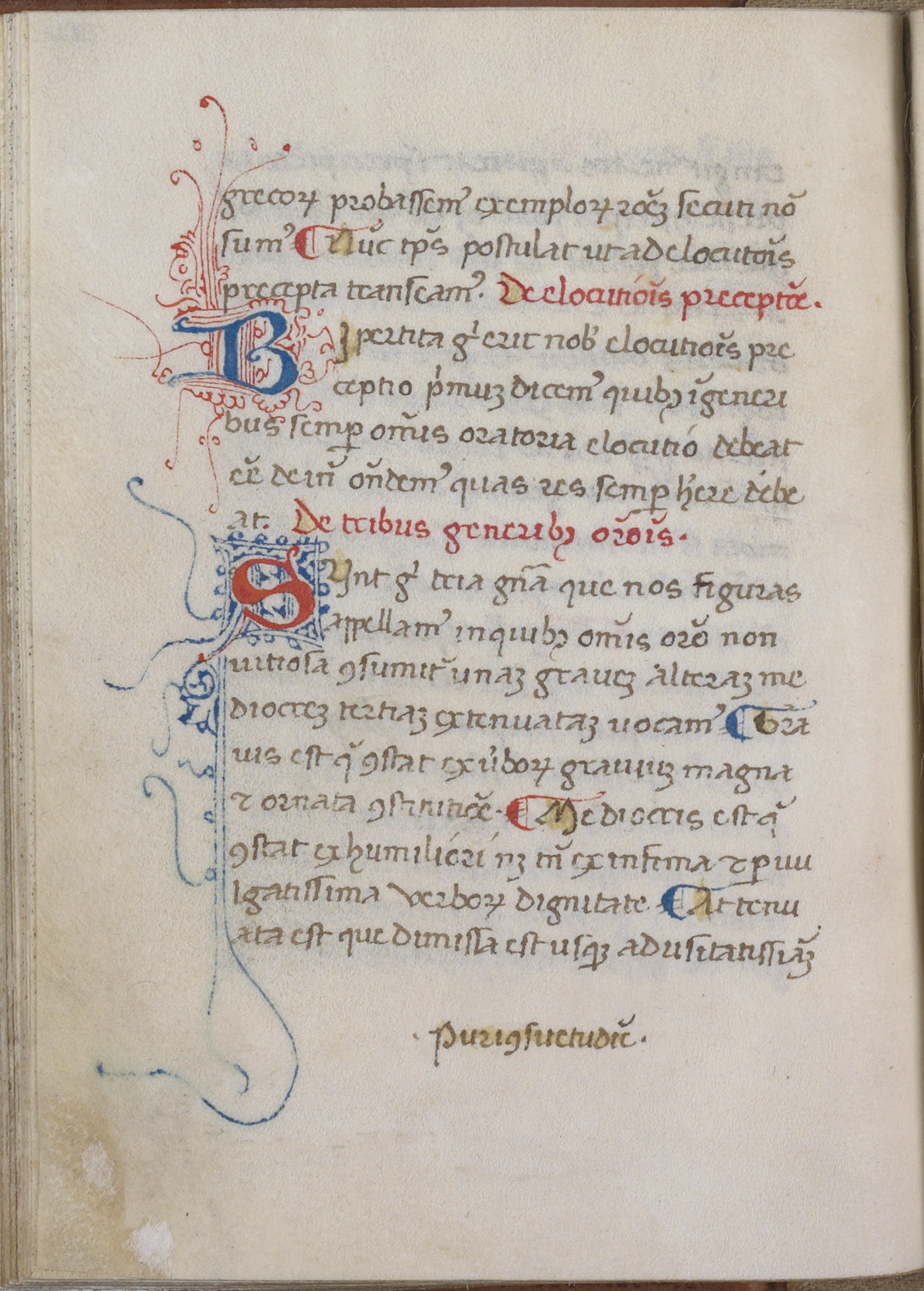During 2012-13, the University of Pennsylvania Rare Book Collection acquired two important medieval manuscripts that show the revival of Ciceronian rhetorical study in the later Middle Ages.
Ms. Codex 1629 - Commentaria ad Rhetoricam Ciceronis
The author of this commentary is unknown, although it is likely that he was a Dominican. The interest of the commentary lies in its position at the beginning of new commentative interest in the Ciceronian rhetorics after the dry years of the thirteenth century. While Cicero's own youthful work, the De inventione, was much read during the early and central Middle Ages, the Rhetorica ad Herennium only really came into its own as a theoretical resource after about 1100, and from the second half of the twelfth century overshadowed the De inventione. But neither text received much new attention during the thirteenth century, because the study of eloquence was not part of the curriculum of university arts faculties. This does not mean that ancient rhetoric was not studied, but rather that most of the advanced academic contexts did not promote new commentaries on the older texts. The Ciceronian rhetorics remained relevant to the study of dictamen (the art of letter writing), but this field encouraged the production of new, practical textbooks rather than commentaries on the ancient texts. However, from the fourteenth century onwards, the religious orders, especially the Benedictines in Oxford and the mendicant studia in Italy, began to show great interest in Ciceronian rhetoric, and here the Ad Herennium was considered more useful perhaps because it is a complete course on the art. The Plena et perfecta commentary illustrates the course of study in mendicant circles and the expansion of rhetorical thought because of its application to preaching, business and bureaucratic needs, and arguing against heresy.
There is no edition of this commentary, which survives only in four manuscripts (two manuscripts in Italian archives, one held in the Bodleian Library, and one now held at the University of Pennsylvania).
The Plena et perfecta commentary gives us a clear picture of medieval glossing practices and education. It is a complete, free-standing commentary on the text, thus embodying the importance of that practice; and it is a working text, its annotations showing how rhetorical teaching was put to use for pragmatic purposes. The manuscript illustrates the practical value of rhetorical teaching outside the universities.
Penn's Rare Book and Manuscript collection also acquired a complete copy of the Rhetorica ad Herennium itself, from fifteenth-century Italy: Ms. Codex 1630 - Rhetorica ad Herennium.
This manuscript gives a superb vista into late-medieval/early humanist practical uses of the Ad Herennium. As noted above, the Ad Herennium had begun to supersede the De inventione in popularity by the end of the twelfth century, and in this mid-fifteenth-century copy we can see some reasons for this shift: the Ad Herennium is a complete rhetoric, it teaches things that people needed to know, it has sections on memory and delivery and style as well as technical precepts for invention. All of these "value-added features" are brought together in a small, elegant but inexpensive, and convenient form in the fifteenth-century copy.
This Ad Herennium manuscript also offers a nice complement to the Plena et perfecta commentary. The Plena et perfecta is a Dominican product, an aid to learning the classical text for the purposes of preaching and even arguing against heresy (a special job of the Dominicans). The fifteenth-century Ad Herennium text, by contrast, is a portable book, probably designed for handy reference by either a preacher or some other kind of public speaker. It is the kind of object that could have been as valuable for a political speaker as for a religious preacher. Thus in these two manuscripts we have contrasting uses for the same material: close study of a lemmatic commentary in a volume that was not obviously designed to be portable; and the Ciceronian text itself in a portable form, without glossing but with handy rubrication for easy reference.

